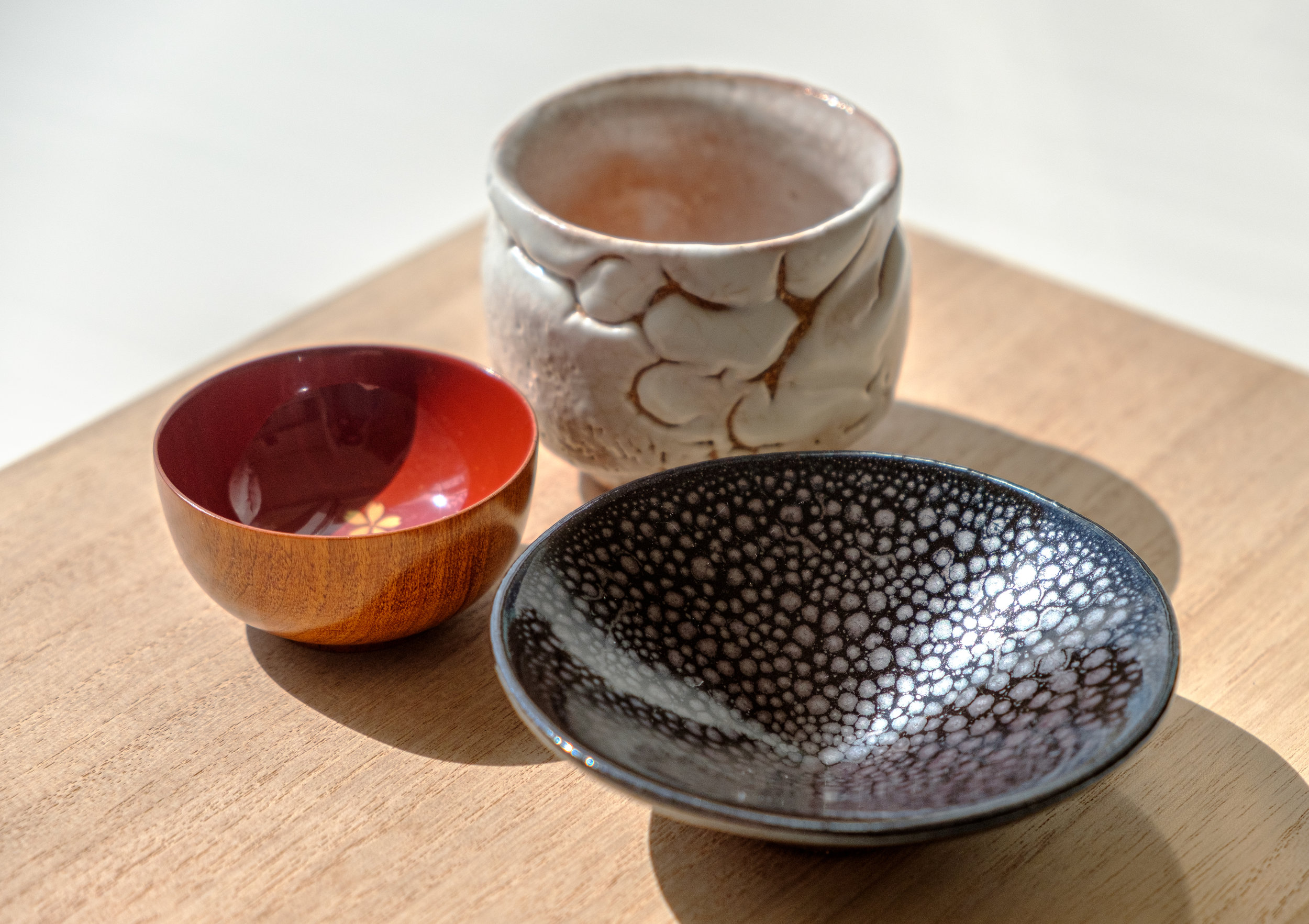Serving Sake
The small cups traditionally used for serving sake are often mistaken for shot glasses. But there’s a whole range of vessels for sake, in all kinds of materials. Let’s have a look at some of the options and how to best enjoy sake at home!
Traditional
Traditionally, sake is drunk from small cups of various shapes: small, cylindrical ochoko; slightly larger, bowl-shaped guinomi; and the elegant saucer-like sakazuki. These can be of ceramics or stoneware, glass, tin, or lacquerware and are fun to collect.
Japanese ceramics is an interesting topic in itself and each region has distinct styles. A guinomi by a famous artisan is a small work of art and will be priced accordingly (stay tuned for a look at Japanese ceramics in a later article!).
A thoughtful server will match your cup to the style of the sake — for example choosing a narrow glass of cut crystal for a crisp and light sake, or a thick guinomi with soft edges for a rich junmai.
But the generally small size makes it difficult to enjoy the aroma, as there is very little surface to smell from. The shape has been dictated more by custom than by taste. Refilling the cup of your guests or superiors is an important part of Japanese drinking culture, and the small size gives you a chance to refill more often. Also, sake used be stronger and less fragrant than what we drink now; the aromatic ginjjo style that benefits from a larger glass was only invented relatively recently.
Professional
Brewery workers and judges at competitions use a special cup with two concentric blue rings (called a ‘snake eye’) to judge colour and clarity. The contrast between the white ceramic and blue paint makes it easy to spot even a faint tinge of colour. The blue rings also help the judges find any impurity or cloudiness.
Smaller versions of these cups are popular in bars and as souvenirs at sake festivals and can also be bought in almost any home- or kitchenware-shop in Japan.
At Home
Let’s be honest, only few of us actually buy dedicated glassware for each type of wine or other drinks. And no matter what some companies might want you to believe, that’s perfectly fine!
For chilled sake (like aromatic ginjo or daiginjo), the glass that brings out the aromas the best is also the one you most likely already have in your home: a tulip-shaped glass just like you would use for white wine. This shape of the glass with its wide belly and narrower opening captures the delicate floral and fruity aromas and concentrates them in the bowl.
The ISO tasting glass was originally developed as a standardised instrument for wine tasting but works for sake as well. It is widely available at low prices and the shape is standardised, so all brands are more or less the same. It’s also an ideal glass if you want to get more serious with sake and keep a tasting notebook, but might not be the most elegant option for the dinner table.
If you want to go all-in and invest in fancy glassware specifically for sake, there are multiple options. Austrian giant Riedel has both a daiginjo glass and a junmai glass (photo). The latter was developed in close cooperation with brewers and sake experts in Japan an is especially suited for more modern styles of junmai that have a bit higher acidity, a full body and umami-rich taste.
Japanese brand Kimura Glass is popular with restaurants and upscale bars in Japan and has a whole range of glasses suitable for sake. Also from Japan is Shotoku Glass, a company famous for producing very thin glassware (they used to make lightbulbs!). Their daiginjo glass has an eye-catching design and is popular as a gift.
Any of these glasses would be perfect for sake.
Warm sake
Warm sake on the other hand is best enjoyed from a small but thick-walled ceramic cup. In a wine glass it would cool too quickly and the steam will fog up the glass, which could also break due to the sudden temperature shock. In a pinch, a clean(!) espresso cup or even an egg cup will do.
But if you plan on enjoying warm sake more often, try to find a nice ceramic ochoko or guinomi or have a look at set of two cups with a carafe made of tin.
Other Options
A Masu [升] is a square box of wood or lacquerware. They come in different sizes and were originally used as a measurement for rice and other dry goods.
If you’ve been to a bar or izakaya in Japan, you might have been served sake in a glass that was placed in a square wooden box, a masu. The glass is then filled until it overflows, probably accompanied by a lot of oohs! and aahs! and surprised faces. It’s a sign of generosity, but can be a bit messy to do at home. You first drink the sake from the glass (don’t put it back in the masu) and then use the remaining sake from the box to refill (usually, the amount left will fit perfectly in your empty glass).
Sake can also be served directly in the masu. In Japan, this is done at festive occasions such as weddings or store openings, when a barrel of sake is cracked open. To be honest, the shape is rather impractical and difficult to drink from (drink from the corner, not the side). Also, the wooden box, which is often made of Japanese cedar, will have a rather strong aroma of its own, and will overshadow the finer nuances of a more delicate sake.
Sometimes, there will be a little salt on the corner of the masu which is meant to increase the umami of the sake; take some salt with your fingertip and then a sip of the sake. This is a custom from a time when all sake used to be made of less polished rice and was stronger in flavour; it isn’t usually done anymore.
A more common way of serving sake in Japanese bars is to place the glass on a saucer. The glass is generously filled to the brim, but usually doesn’t overflow.
Experiment!
Most importantly, don’t forget to experiment. Try different combinations and see how your perception of the sake changes in one glass compared to another.
Are the aromas more muted or are they amplified? How does the sake enter your mouth? Does the shape, weight, and feel of the vessel change your perception of the sake?












